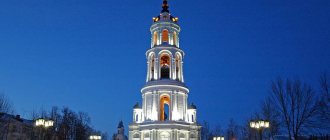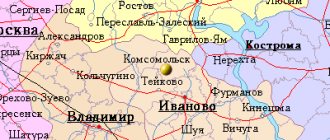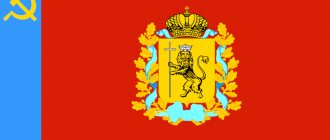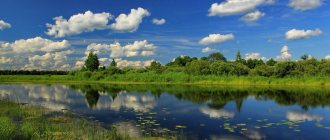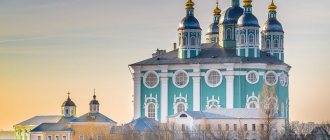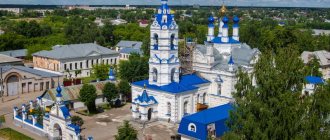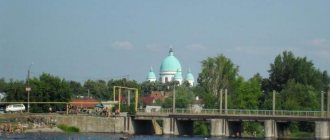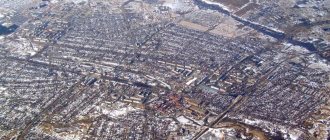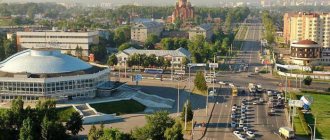Included in the Ivanovo region
Russia includes 30
urban settlements
, including[1][2]:
- 17 cities, among which the following stand out: 6 cities outside the districts (corresponding to the category of cities of regional subordination) - highlighted
in orange in the list - form urban districts within the framework of the organization of local self-government; - 11 cities within districts (corresponding to the category of cities of district subordination) - within the framework of the organization of local self-government, they are included in the corresponding municipal districts;
Data by year
In 1871, when Ivanovo-Voznesenk received city status, 20,000 people lived in it. It grew quite quickly and in 1897 the number of residents was already 54,200, in 1914 - 146,000, and in 1917 - 174,400. The Civil War led to a sharp reduction in the number of city residents. In 1923 it was only 71,800 people. Pre-revolutionary indicators were achieved and surpassed only in the late 20s and early 30s. In 1931, statistics showed that 177,200 people lived in Ivanovo.
The policy of industrialization gave a new powerful impetus to the growth of the Ivanovo population. In 1939, its population was 285,182 people. Subsequently, this figure grew steadily. In 1956 it was 319,000, 1979 - 464,526, 1991 - 48,200.
The structural crisis of the 90s, associated with the destruction of the economy and social sphere of our country, led to a sharp deterioration in demographics in the city of Ivanovo. In dynamics, information about the number of its inhabitants looks like this:
- 1992 - 480,000 people.
- 1998 — 464000.
- 2001 — 452100.
- 2009 — 404539.
Then there was some stabilization. In 2011, the number of residents in the regional center was 409,300. But this did not lead to a radical improvement in the situation and further demographic decline continued. According to current information, the number of residents as of 2016 was 408,025, and in 2022 it is already 404,598. According to this parameter, the Ivanovo urban district ranks 49th in the Russian Federation.
Cities[ | ]
| № | Name | district/city[4] | municipal district / urban district[5] | population (persons) | founding/first mention | city status | coat of arms | former names |
| 1 | Vichuga | Vichuga | Vichuga, GO | ↘32 971[3] | 1925 | 1925 | ||
| 2 | Gavrilov Posad | Gavrilovo-Posadsky district | Gavrilovo-Posad municipal district | ↘5492[3] | 1434 | 1789 | ||
| 3 | Zavolzhsk | Zavolzhsky district | Zavolzhsky municipal district | ↘9484[3] | 19th century | 1954 | until 1934 - Vladychnoye until 1954 - Volga region | |
| 4 | Ivanovo | Ivanovo | Ivanovo, GO | ↘401 505[3] | 1561 | 1871 | until 1932 - Ivanovo-Voznesensk | |
| 5 | Kineshma | Kineshma | Kineshma, GO | ↘79 936[3] | 1429 | 1504 | ||
| 6 | Komsomolsk | Komsomolsky district | Komsomolsky municipal district | ↘7978[3] | 1931 | 1950 | ||
| 7 | Kokhma | Kokhma | Kokhma, GO | ↗30 336[3] | 1619 | 1925 | ||
| 8 | Navoloki | Kineshma district | Kineshma municipal district | ↘8988[3] | 1775 | 1938 | ||
| 9 | Plyos | Privolzhsky district | Privolzhsky municipal district | ↗1734[3] | 1410 | 1925 | ||
| 10 | Privolzhsk | Privolzhsky district | Privolzhsky municipal district | ↘15 085[3] | 1484 | 1938 | until 1924 - Yakovlevskoye until 1938 - Yakovlevsky | |
| 11 | Puchezh | Puchezhsky district | Puchezhsky municipal district | ↘6010[3] | 1594 | 1793 | ||
| 12 | Springs | Rodnikovsky district | Rodnikovsky municipal district | ↘23 895[3] | 1606 | 1918 | ||
| 13 | Teykovo | Teykovo | Teykovo, GO | ↘31 623[3] | 1613 | 1918 | ||
| 14 | Furmanov | Furmanovsky district | Furmanovsky municipal district | ↘32 855[3] | 1918 | 1918 | until 1918 - Sereda-Upino until 1941 - Sereda | |
| 15 | Shuya | Shuya | Shuya, GO | ↘56 041[3] | 1539 | 1778 | Borisoglebskaya Sloboda | |
| 16 | Yuzha | Yuzhsky district | Yuzhsky municipal district | ↘12 011[3] | 1628 | 1925 | ||
| 17 | Yuryevets | Yurievetsky district | Yuryevetsky municipal district | ↘7837[3] | 1225 | 1778 |
According to OKATO, Kokhma is listed as part of the district, and the city of regional subordination is Furmanov[6].
Settlements that have lost their city status[ | ]
Preserved, but lost city status:
- Lukh is now a town, a city from 1778 to 1925.
About the city
At the beginning of its history, Ivanovo was a settlement. This is how unfortified rural settlements are designated in archeology. The first written mention of the village dates back to 1608. During the Time of Troubles, it was captured by Polish invaders and was severely devastated. But it was restored quite quickly. Due to low soil fertility, farming was not a profitable activity here, and soon crafts, including textiles, became the main occupation of local residents.
At the end of the 17th century, the village was a famous center of Russian weaving. In the middle of the 18th century, the first manufactories appeared here. This is what science calls industrial enterprises with manual labor, but in which there is already specialization between workers. They were founded by capitalist peasants (entrepreneurs who came from the peasant class).
In 1853, Voznesensky Posad appeared nearby. In 1871 it merged with the village of Ivanovo, as a result of which the city of Ivanovo-Voznesensk arose, which immediately became one of the main centers of the textile industry of the Russian Empire. In 1932 the city received its modern name.
During Soviet times, the city remained the largest center of domestic and global textile production. At the same time, a number of large mechanical engineering plants were built. By the way, it was largely thanks to textile production that Ivanovo received its nickname “the city of brides.” After all, weaving work was traditionally female work and many young girls worked in Ivanovo factories.
For the Ivanovo region, small towns are a special priority
Governor Stanislav Voskresensky says.
Russian President Vladimir Putin, during his annual press conference on December 23, spoke about plans for the development of small towns in Russia.
– Cities, both small and large, are developing, developing quite energetically, although, first of all, we now need to pay attention to the development of small towns – we have always been talking about this lately. And we are making efforts related to the development of infrastructure, first of all, the connectivity of territories by railways, roads, air transport, sea and river transport - I have already spoken about this, this is one of the drivers of growth in which we expect to invest colossal resources ,” said Vladimir Putin.
Governor of the Ivanovo region Stanislav Voskresensky noted that small towns are of particular importance for our region.
– For the Ivanovo region, small towns are a special priority. We have been transforming them for several years now. We reached almost every small town. We restored the roads between them, and began to actively engage in transport connectivity between our cities and with the regional center ,” said Stanislav Voskresensky.
Thus, since 2022, work has been underway in the region to bring the framework of roads to a standard state: roads between small towns and the capital of the region, roads connecting small towns with each other. This year, 400.5 km of roads were repaired: 22 regional highways, 345 roads and streets in municipalities, including under the national project “Safe Quality Roads”. And in total, since 2022, based on the results of the work performed, 1051 km of the core network, or 95.1%, are in standard condition. In 2022, we also began repairing roads to small settlements; in total, 16 such roads with a length of 58.2 km were repaired.
This year, a new suburban railway network was created in the Ivanovo region. Currently, the region’s transport scheme includes 48 commuter trains, and the frequency of service has doubled. The commuter schedule has been adjusted so that passengers can easily transfer from one train to another. The schedule is also synchronized with the schedule of a number of Lastochka trains from Ivanovo to Moscow.
Another component of working in small towns is creating a comfortable urban environment. Since 2022, the region has won 18 grants from the All-Russian Landscaping Competition for 14 small towns in the region, including five cities this year. So, next year they will begin work in Kokhma, Zavolzhsk and again in Yuryevets, Kineshma and Teykovo.
Infrastructure development in the Russian Federation is one of the drivers of the country’s growth, including economic growth, added Vladimir Putin. He said that serious resources are allocated annually for these purposes.
Gender and age
The gender and age structure fully justifies the nickname “city of brides.” Characterized by a significant predominance of the female population over the male population. According to the same census, there were 228,758 representatives of the fair sex in the urban district in 2010, and 179,572 men.
This trend is fully consistent with the indicators characterizing the population of the Ivanovo region as a whole. According to data for 2022, the number of women in the region per 1000 men is 1217.
The age structure of the population of the urban district is as follows. As of 2010, there were 56,128 children aged 0 to 15 years. The number of people of working age was 266,873, and pensioners over the age of 60 were 85,329.
Migration
Migration flows in the city are very contradictory. On the one hand, as a result of internal migration there is an outflow of population. Moscow is in first place in terms of the number of people leaving, St. Petersburg is in second place.
The balance of external migration is positive. Mainly due to citizens of former Soviet Asian republics. But this fact cannot indicate the attractiveness of life in the region. The overwhelming majority of migrants do not seek to stay here permanently, but, after working for some time, go home.
At the moment, we can confidently state that negative demographic trends in Ivanovo have not yet been overcome. Only a radical improvement in the economic situation in the city can turn the situation around.
Urban settlements[ | ]
| № | Name | district[4] | municipal district[5] | population (persons) | founding/first mention | town status | coat of arms | former names |
| 1 | Upper Landeh | Verkhnelandekhovo district | Verkhnelandekhovo municipal district | ↘1618[3] | 1621 | 1985 | ||
| 2 | Ilyinskoye-Khovanskoye | Ilyinsky district | Ilyinsky municipal district | ↘2821[3] | 1619 | 1979 | ||
| 3 | Kamenka | Vichuga district | Vichuga municipal district | ↘3433[3] | 1939 | |||
| 4 | Kolobovo | Shuisky district | Shuisky municipal district | ↘2324[3] | 1941 | |||
| 5 | Lezhnevo | Lezhnevsky district | Lezhnevsky municipal district | ↘7546[3] | 1239 | 1925 | ||
| 6 | Luh | Lukhsky district | Lukhsky municipal district | ↘2580[3] | 1404 | 1959 | ||
| 7 | Nerl | Teykovsky district | Teykovsky municipal district | ↗1789[3] | 1927 | |||
| 8 | Novopistsovo | Vichuga district | Vichuga municipal district | ↘2158[3] | 1938 | |||
| 9 | Palekh | Palekh district | Palekh municipal district | ↘4610[3] | 1618 | 1947 | ||
| 10 | Pestyaki | Pestyakovsky district | Pestyakovsky municipal district | ↘3165[3] | 1379 | 1959 | Pistyaki | |
| 11 | Petrovsky | Gavrilovo-Posadsky district | Gavrilovo-Posad municipal district | ↘2164[3] | 1938 | |||
| 12 | Savino | Savinsky district | Savinsky municipal district | ↘4760[3] | 1869 | 1938 | ||
| 13 | Old Vichuga | Vichuga district | Vichuga municipal district | ↘4615[3] | 1938 |
Settlements that have lost the status of an urban-type settlement[ | ]
- Arkhipovka has been a town since 1948. Transformed into a rural settlement in 2009[7].
- Dolmatovsky has been a town since 1941. Transformed into a rural settlement in 2002[8].
- Dulyapino has been a town since 1938. Transformed into a rural settlement in 2003[9].
- Zavolzhye has been a town since 1934. Incorporated into a city in 1954.
- Zarechny has been a town since 1957. Transformed into a rural settlement in 2004[10].
- Ivankovsky has been a town since 1949. Transformed into a rural settlement in 2002[8].
- Kaminsky has been a town since 1947. Transformed into a rural settlement in 2004[10].
- Komsomolsky has been a town since 1931. Incorporated into a city in 1950.
- Koptevo has been a town since 1949. Converted to a rural settlement in 1961.
- Markovo has been a town since 1940. Transformed into a rural settlement in 2004[10].
- Mosta has been a town since 1946. Transformed into a rural settlement in 2004[10].
- Mugreevsky has been a town since 1942. Transformed into a rural settlement in 2004[10].
- Navoloki has been a town since 1925. Incorporated into a city in 1938.
- Novoe Leushino has been a town since 1939. Converted to a rural settlement in 2004.
- New Gorki has been a town since 1950. Transformed into a rural settlement in 2004[10].
- Ozerny has been a town since 1949. Transformed into a rural settlement in 2002[8].
- Oktyabrsky has been a town since 1941. Transformed into a rural settlement in 2004[10].
- Panfilovo has been a town since 1944. Transformed into a rural settlement in 2004[10].
- Pistsovo has been a town since 1925. Transformed into a rural settlement in 2004[10].
- Podozersky has been a town since 1949. Transformed into a rural settlement in 2004[10].
- Talitsy has been a town since 1991. Transformed into a rural settlement in 2004[10].
- Kholuy has been a town since 1946. Transformed into a rural settlement in 2004[10].
- Yakovlevskoye has been a town since 1925. Transformed into the city of Privolzhsk in 1938.
